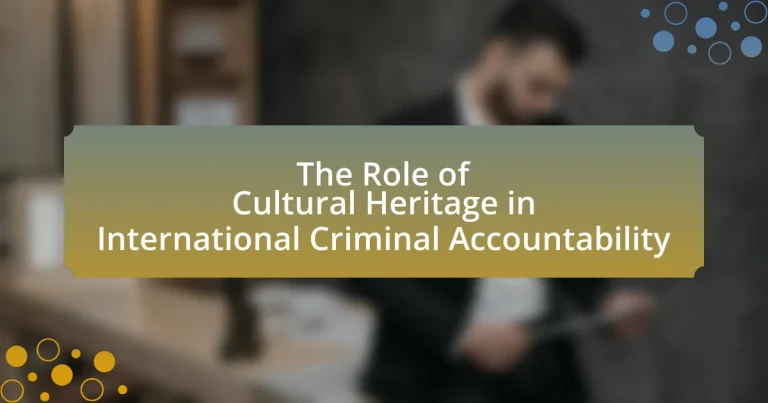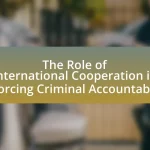Cultural heritage is a vital component of international criminal accountability, serving as a foundation for legal frameworks that protect cultural property during armed conflicts and other crimes. The article examines how the destruction of cultural heritage is classified as a war crime under the Rome Statute of the International Criminal Court, emphasizing the necessity of preserving cultural identity and history. It discusses the influence of cultural heritage on international criminal law, key definitions, protective measures under international law, and the significance of cultural heritage in the context of international crimes. Additionally, the article addresses the challenges in enforcing accountability, the role of international tribunals and national courts, and best practices for enhancing legal frameworks and international cooperation in cultural heritage protection.

What is the Role of Cultural Heritage in International Criminal Accountability?
Cultural heritage plays a crucial role in international criminal accountability by serving as a basis for legal frameworks that protect cultural property during armed conflicts and other crimes. The destruction of cultural heritage is recognized as a war crime under the Rome Statute of the International Criminal Court, which emphasizes the importance of preserving cultural identity and history. For instance, the prosecution of individuals for the destruction of the Buddhas of Bamiyan in Afghanistan in 2001 illustrates how cultural heritage can be a focal point for accountability, as it highlights the need to uphold international norms against cultural crimes. This legal recognition reinforces the idea that attacks on cultural heritage are not only assaults on history but also violations of human rights, thereby holding perpetrators accountable on an international scale.
How does cultural heritage influence international criminal law?
Cultural heritage significantly influences international criminal law by shaping legal frameworks that protect cultural property during armed conflicts and preventing crimes against humanity. The 1954 Hague Convention for the Protection of Cultural Property in the Event of Armed Conflict exemplifies this influence, establishing legal obligations for states to safeguard cultural heritage. Additionally, the Rome Statute of the International Criminal Court includes the destruction of cultural heritage as a war crime, reflecting the recognition of cultural property’s importance to identity and history. This legal recognition underscores the necessity of protecting cultural heritage as a means of preserving human dignity and promoting accountability for violations.
What are the key definitions of cultural heritage in this context?
Cultural heritage refers to the legacy of physical artifacts and intangible attributes inherited from past generations, encompassing monuments, sites, traditions, and practices that hold significance for communities. In the context of international criminal accountability, cultural heritage is defined as the collective cultural identity that must be protected from destruction and illicit trafficking, as its preservation is essential for maintaining historical continuity and fostering social cohesion. This definition is supported by international legal frameworks such as the 1954 Hague Convention for the Protection of Cultural Property in the Event of Armed Conflict, which emphasizes the obligation of states to safeguard cultural heritage during conflicts, thereby reinforcing its importance in the realm of international law and accountability.
How is cultural heritage protected under international law?
Cultural heritage is protected under international law primarily through treaties and conventions that establish obligations for states to safeguard and preserve cultural sites and artifacts. Key instruments include the 1954 Hague Convention for the Protection of Cultural Property in the Event of Armed Conflict, which mandates that parties to a conflict must take measures to protect cultural property from destruction and theft. Additionally, the 1972 UNESCO World Heritage Convention encourages the identification and preservation of cultural heritage sites of outstanding universal value, obligating signatory states to ensure their protection. These legal frameworks are reinforced by customary international law and the principles of international humanitarian law, which impose responsibilities on states and individuals to prevent the illicit trafficking of cultural property and to prosecute those who commit crimes against cultural heritage.
Why is cultural heritage significant in the context of international crimes?
Cultural heritage is significant in the context of international crimes because it embodies the identity, history, and values of communities, making its destruction a violation of human rights and international law. The intentional targeting of cultural heritage, as seen in conflicts like the Syrian Civil War and the destruction of the Buddhas of Bamiyan in Afghanistan, illustrates how such acts can be used as tools of war to erase cultural identity and undermine social cohesion. The 1954 Hague Convention for the Protection of Cultural Property in the Event of Armed Conflict establishes legal frameworks that recognize the importance of safeguarding cultural heritage during conflicts, reinforcing its role in promoting peace and accountability.
What types of international crimes involve cultural heritage?
International crimes involving cultural heritage include the illicit trafficking of cultural property, destruction of cultural heritage sites, and war crimes targeting cultural assets. The 1954 Hague Convention for the Protection of Cultural Property in the Event of Armed Conflict specifically addresses the protection of cultural heritage during warfare, establishing that intentional destruction of cultural sites constitutes a war crime. Additionally, the UNESCO Convention on the Means of Prohibiting and Preventing the Illicit Import, Export and Transfer of Ownership of Cultural Property emphasizes the illegal trade of cultural artifacts as a significant international crime. These frameworks highlight the importance of safeguarding cultural heritage and the legal repercussions for violations.
How does the destruction of cultural heritage impact communities?
The destruction of cultural heritage severely impacts communities by eroding their identity and social cohesion. When cultural sites are lost, communities experience a disconnection from their history and traditions, which can lead to a diminished sense of belonging and purpose. For instance, UNESCO reports that the loss of heritage sites can result in economic decline, as tourism often relies on cultural landmarks, further exacerbating community instability. Additionally, the destruction of cultural heritage can incite conflict and violence, as seen in regions where cultural symbols are targeted to undermine social unity. This loss not only affects the present but also jeopardizes future generations’ ability to connect with their cultural roots.
What mechanisms exist for holding individuals accountable for crimes against cultural heritage?
Individuals can be held accountable for crimes against cultural heritage through various legal mechanisms, including international treaties, national laws, and judicial processes. Internationally, the 1954 Hague Convention for the Protection of Cultural Property in the Event of Armed Conflict establishes obligations for states to protect cultural heritage and provides a framework for prosecution. Additionally, the Rome Statute of the International Criminal Court recognizes the destruction of cultural heritage as a war crime, allowing for individual prosecution. National laws also play a crucial role; many countries have enacted legislation that criminalizes the illicit trade and destruction of cultural property. For instance, the United States has the Archaeological Resources Protection Act, which penalizes the unauthorized excavation and removal of archaeological resources. These mechanisms collectively ensure that individuals who commit crimes against cultural heritage can be prosecuted and held accountable.
What role do international tribunals play in these cases?
International tribunals play a crucial role in adjudicating cases related to cultural heritage violations in the context of international criminal accountability. They provide a legal framework for prosecuting individuals responsible for the destruction or illicit trafficking of cultural property, thereby reinforcing the protection of cultural heritage under international law. For instance, the International Criminal Court (ICC) has jurisdiction over war crimes that include the intentional destruction of cultural heritage, as established in the Rome Statute. This legal precedent underscores the importance of holding perpetrators accountable and serves to deter future violations, thereby promoting respect for cultural heritage globally.
How do national courts address crimes against cultural heritage?
National courts address crimes against cultural heritage by implementing specific laws and legal frameworks that criminalize the destruction, theft, or illicit trafficking of cultural property. For instance, many countries have ratified international treaties such as the 1954 Hague Convention for the Protection of Cultural Property in the Event of Armed Conflict, which obligates them to prosecute individuals responsible for such crimes. Additionally, national legislation often incorporates provisions that align with these international standards, allowing courts to impose penalties on offenders. In practice, cases have been prosecuted under laws that define cultural heritage crimes, such as the prosecution of individuals involved in the looting of archaeological sites or the destruction of historical monuments, demonstrating the commitment of national courts to uphold cultural heritage protection.

What challenges exist in enforcing accountability for cultural heritage crimes?
Enforcing accountability for cultural heritage crimes faces significant challenges, primarily due to jurisdictional issues, lack of legal frameworks, and insufficient resources. Jurisdictional challenges arise when cultural heritage crimes occur across borders, complicating the prosecution process as different countries may have varying laws and enforcement capabilities. The absence of comprehensive legal frameworks specifically addressing cultural heritage crimes further hampers accountability, as many nations lack the necessary legislation to prosecute offenders effectively. Additionally, inadequate resources, including funding and trained personnel, limit the ability of law enforcement agencies to investigate and prosecute these crimes thoroughly. These factors collectively contribute to a landscape where cultural heritage crimes often go unpunished, undermining international efforts to protect cultural heritage.
What are the legal obstacles to prosecuting crimes against cultural heritage?
Legal obstacles to prosecuting crimes against cultural heritage include jurisdictional issues, lack of specific legal frameworks, and challenges in gathering evidence. Jurisdictional issues arise because cultural heritage crimes often cross national borders, complicating the enforcement of laws. Many countries lack comprehensive legal frameworks specifically addressing cultural heritage protection, which can lead to inconsistent application of laws. Additionally, gathering evidence can be difficult due to the clandestine nature of such crimes and the need for specialized knowledge to assess the value and significance of cultural artifacts. These factors collectively hinder effective prosecution and accountability for crimes against cultural heritage.
How do jurisdictional issues complicate accountability?
Jurisdictional issues complicate accountability by creating legal ambiguities regarding which court or authority has the power to prosecute crimes, particularly in international contexts. For instance, when cultural heritage crimes occur across borders, differing national laws and varying interpretations of jurisdiction can hinder the ability to hold perpetrators accountable. The International Criminal Court (ICC) operates under specific jurisdictional criteria, which may not align with national laws, leading to gaps in enforcement. Additionally, the principle of state sovereignty can prevent international bodies from intervening, as seen in cases where nations refuse to extradite suspects or cooperate with investigations. This complexity is evident in the 2017 case of the destruction of cultural heritage in Syria, where multiple jurisdictions were involved, complicating efforts to prosecute those responsible.
What evidentiary challenges arise in these prosecutions?
Evidentiary challenges in prosecutions related to cultural heritage often include the difficulty of establishing the provenance of artifacts, the need for expert testimony to validate the significance of cultural items, and the complexities of gathering evidence in conflict zones. Provenance issues arise when it is hard to trace the ownership history of artifacts, which can complicate claims of theft or illegal trade. Expert testimony is crucial, as courts require specialists to interpret the cultural and historical context of the items, but such experts may be scarce or biased. Additionally, gathering evidence in conflict zones is fraught with risks, including the destruction of evidence and the inability to access sites, which can hinder the prosecution’s ability to build a strong case. These challenges are underscored by cases such as the prosecution of individuals for the destruction of cultural heritage in Syria, where the lack of accessible evidence significantly impacted the legal proceedings.
How do political factors influence accountability for cultural heritage crimes?
Political factors significantly influence accountability for cultural heritage crimes by shaping legal frameworks, enforcement mechanisms, and international cooperation. Governments may prioritize cultural heritage protection based on political agendas, leading to varying levels of commitment to prosecuting offenders. For instance, during conflicts, regimes may exploit cultural heritage for propaganda or economic gain, undermining accountability. Additionally, international treaties like the 1954 Hague Convention require state parties to uphold cultural heritage laws, but political will often dictates compliance. Countries with stable governance and strong rule of law tend to enforce accountability more effectively, while those with political instability may lack the resources or motivation to address cultural heritage crimes adequately.
What role does state sovereignty play in these cases?
State sovereignty plays a crucial role in cases involving cultural heritage and international criminal accountability by determining the extent to which states can control their own cultural resources and the legal frameworks governing them. Sovereign states have the authority to legislate and enforce laws regarding the protection of their cultural heritage, which can influence international legal proceedings and accountability measures. For instance, the 1970 UNESCO Convention emphasizes the importance of state sovereignty in protecting cultural property, asserting that states have the primary responsibility for safeguarding their heritage. This principle can complicate international efforts to hold individuals accountable for crimes against cultural heritage, as states may resist external intervention, citing their sovereign rights.
How can international relations affect the prosecution of cultural heritage crimes?
International relations significantly influence the prosecution of cultural heritage crimes by shaping legal frameworks, cooperation among nations, and the prioritization of cultural preservation. For instance, treaties such as the 1954 Hague Convention for the Protection of Cultural Property in the Event of Armed Conflict establish international norms that countries are encouraged to follow, promoting accountability for cultural heritage crimes. Additionally, diplomatic relations can facilitate or hinder collaboration in investigations and prosecutions, as seen in cases where countries with strained relations may refuse to extradite individuals accused of such crimes. Furthermore, international organizations like UNESCO play a crucial role in advocating for the protection of cultural heritage, thereby impacting how nations approach prosecution efforts.

What are the best practices for enhancing accountability in cultural heritage protection?
The best practices for enhancing accountability in cultural heritage protection include establishing clear legal frameworks, promoting community involvement, and implementing robust monitoring systems. Clear legal frameworks, such as the 1954 Hague Convention for the Protection of Cultural Property in the Event of Armed Conflict, provide guidelines for safeguarding cultural heritage during conflicts. Community involvement ensures that local populations participate in decision-making processes, fostering a sense of ownership and responsibility towards their heritage. Additionally, robust monitoring systems, including the use of technology for real-time tracking of cultural sites, enhance oversight and deter illicit activities. These practices collectively strengthen accountability by ensuring that stakeholders are informed, engaged, and held responsible for the protection of cultural heritage.
How can international cooperation improve accountability for cultural heritage crimes?
International cooperation can improve accountability for cultural heritage crimes by facilitating the sharing of information, resources, and best practices among nations. Collaborative efforts, such as the 1970 UNESCO Convention, enable countries to work together to combat illicit trafficking of cultural property, leading to more effective law enforcement and legal frameworks. For instance, joint investigations and training programs enhance the capacity of national authorities to prosecute offenders, as evidenced by successful operations like Operation Pandora, which targeted art trafficking networks across Europe. Such international partnerships not only strengthen legal accountability but also promote a unified stance against cultural heritage crimes, ensuring that violators face consequences regardless of where the crime occurs.
What role do NGOs play in advocating for cultural heritage protection?
NGOs play a crucial role in advocating for cultural heritage protection by raising awareness, mobilizing communities, and influencing policy. They engage in activities such as conducting research, documenting heritage sites, and providing legal assistance to protect cultural assets from destruction or illicit trafficking. For instance, organizations like UNESCO and the International Council on Monuments and Sites (ICOMOS) work to establish international standards and guidelines for heritage conservation, which are essential for effective advocacy. Additionally, NGOs often collaborate with local governments and international bodies to promote cultural heritage as a vital component of identity and social cohesion, thereby reinforcing its importance in international criminal accountability frameworks.
How can education and awareness contribute to better protection of cultural heritage?
Education and awareness significantly enhance the protection of cultural heritage by fostering understanding and appreciation of its value among individuals and communities. When people are educated about the historical, cultural, and social significance of their heritage, they are more likely to engage in its preservation and protection. For instance, UNESCO reports that educational programs aimed at cultural heritage have led to increased community involvement in safeguarding local sites, as seen in various successful initiatives worldwide. Furthermore, awareness campaigns can inform the public about the legal frameworks protecting cultural heritage, such as the 1954 Hague Convention for the Protection of Cultural Property in the Event of Armed Conflict, which underscores the importance of safeguarding heritage during conflicts. This combination of education and awareness not only empowers communities but also promotes a collective responsibility towards cultural heritage, ultimately leading to more effective protection measures.
What practical steps can be taken to strengthen legal frameworks for cultural heritage?
To strengthen legal frameworks for cultural heritage, governments should adopt comprehensive legislation that explicitly protects cultural sites and artifacts from destruction and illicit trafficking. This can be achieved by ratifying international treaties such as the UNESCO Convention for the Protection of Cultural Property in the Event of Armed Conflict, which establishes legal obligations for states to safeguard cultural heritage during conflicts. Additionally, implementing strict penalties for violations of cultural heritage laws can deter criminal activities. Countries can also enhance collaboration with international organizations and NGOs to share best practices and resources for heritage protection. For instance, the 2017 UNESCO report highlighted the importance of integrating cultural heritage protection into national legal systems, demonstrating that effective legal frameworks can significantly reduce the risk of cultural heritage crimes.
How can countries improve their national laws regarding cultural heritage crimes?
Countries can improve their national laws regarding cultural heritage crimes by adopting comprehensive legal frameworks that specifically address the protection of cultural heritage. This includes enacting laws that criminalize the illicit trafficking of cultural property, as evidenced by the 1970 UNESCO Convention, which encourages nations to prevent and combat such crimes. Additionally, countries should enhance cooperation with international organizations and other states to share information and best practices, as seen in initiatives like INTERPOL’s Project T.E.A.R. (Targeting the Economic and Artistic Resources). Furthermore, implementing stricter penalties for offenders and establishing specialized units within law enforcement agencies can significantly deter cultural heritage crimes, as demonstrated by successful prosecutions in countries like Italy and Greece, which have robust legal measures in place.
What are the benefits of integrating cultural heritage into broader human rights frameworks?
Integrating cultural heritage into broader human rights frameworks enhances the protection of cultural identities and promotes social cohesion. This integration acknowledges the intrinsic link between cultural heritage and human dignity, as recognized by the United Nations Educational, Scientific and Cultural Organization (UNESCO), which states that cultural heritage is essential for the identity and continuity of communities. Furthermore, it facilitates the prevention of cultural destruction during conflicts, as seen in the 2017 UNESCO resolution condemning the destruction of cultural heritage in armed conflicts, which emphasizes the need for safeguarding cultural sites as a human rights imperative. By embedding cultural heritage within human rights frameworks, states are encouraged to uphold their obligations to protect cultural expressions, thereby fostering respect for diversity and promoting peace.
What resources are available for further understanding cultural heritage and accountability?
Resources available for further understanding cultural heritage and accountability include academic journals, books, and online databases focused on cultural heritage law and international accountability. Notable journals such as the “International Journal of Cultural Property” and “Cultural Heritage” provide peer-reviewed articles that explore the intersection of cultural heritage and legal frameworks. Books like “Cultural Heritage and the Law” by Patricia A. McCarty offer comprehensive insights into legal aspects. Additionally, organizations such as UNESCO and the International Council on Monuments and Sites (ICOMOS) publish guidelines and reports that address accountability in the preservation of cultural heritage. These resources collectively enhance the understanding of how cultural heritage is protected and the responsibilities involved in its preservation.


